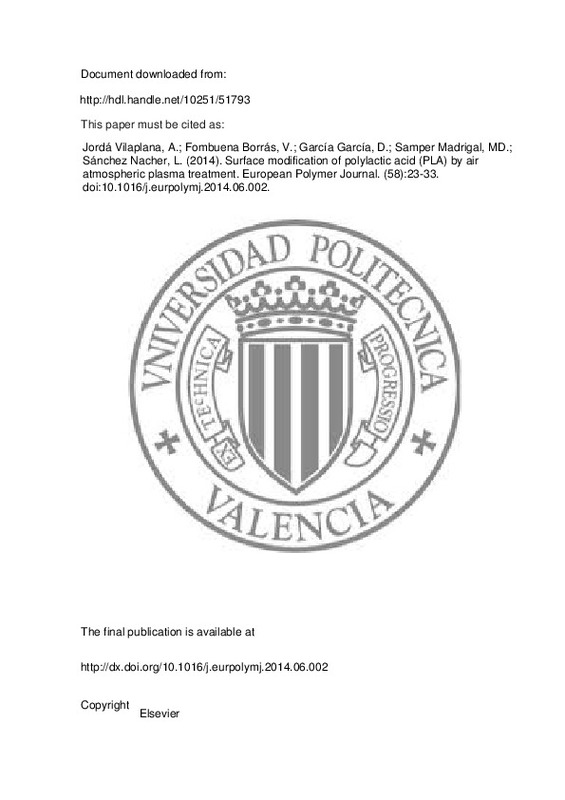JavaScript is disabled for your browser. Some features of this site may not work without it.
Buscar en RiuNet
Listar
Mi cuenta
Estadísticas
Ayuda RiuNet
Admin. UPV
Surface modification of polylactic acid (PLA) by air atmospheric plasma treatment
Mostrar el registro sencillo del ítem
Ficheros en el ítem
| dc.contributor.author | Jordá Vilaplana, Amparo
|
es_ES |
| dc.contributor.author | Fombuena Borrás, Vicent
|
es_ES |
| dc.contributor.author | García García, Daniel
|
es_ES |
| dc.contributor.author | Samper Madrigal, María Dolores
|
es_ES |
| dc.contributor.author | Sánchez Nacher, Lourdes
|
es_ES |
| dc.date.accessioned | 2015-06-16T12:41:55Z | |
| dc.date.available | 2015-06-16T12:41:55Z | |
| dc.date.issued | 2014-09 | |
| dc.identifier.issn | 0014-3057 | |
| dc.identifier.uri | http://hdl.handle.net/10251/51793 | |
| dc.description.abstract | The main objective of this experimental study is the validation of the technique of atmospheric plasma with the aim of improving the surface energy of the polylactic acid (PLA) for further adhesion uses. The wettability of PLA has been improved with the application of an atmospheric plasma surface treatment. This method provides good adhesion properties with the optimizing the process parameters in terms of the nozzle substrate distance and sample advance rate. In order to achieve that goal, a new and environmentally friendly technology has been used which is based on the use of air atmospheric plasma. The effects of the surface treatment on this type of substrates have been analyzed. The macroscopic effects of the process parameters have been determined using contact angle measurements and subsequent surface free energy (SFE) calculation. In addition, the chemical changes at the topmost layers have been studied using X-ray photoelectron spectroscopy (XPS) and Fourier transformed infrared spectroscopy (FTIR). Surface topography changes due to the plasma-acting mechanisms have been evaluated with scanning electron microscopy (SEM) and atomic force microscopy (AFM). The obtained results show a remarkable increase in surface free energy from 37.1 mJ m 2 up to values of 60 mJ m 2 thus indicating the effectiveness of the air plasma treatment. The main advantage of this technology is that the industrial process is continuous, it is easy to establish in current production systems and it does not generate wastes. (C) 2014 Elsevier Ltd. All rights reserved. | es_ES |
| dc.language | Inglés | es_ES |
| dc.publisher | Elsevier | es_ES |
| dc.relation.ispartof | European Polymer Journal | es_ES |
| dc.rights | Reserva de todos los derechos | es_ES |
| dc.subject | Atmospheric plasma | es_ES |
| dc.subject | Polylactic acid | es_ES |
| dc.subject | Wettability | es_ES |
| dc.subject | Surface topography | es_ES |
| dc.subject.classification | CIENCIA DE LOS MATERIALES E INGENIERIA METALURGICA | es_ES |
| dc.subject.classification | EXPRESION GRAFICA EN LA INGENIERIA | es_ES |
| dc.title | Surface modification of polylactic acid (PLA) by air atmospheric plasma treatment | es_ES |
| dc.type | Artículo | es_ES |
| dc.identifier.doi | 10.1016/j.eurpolymj.2014.06.002 | |
| dc.rights.accessRights | Abierto | es_ES |
| dc.contributor.affiliation | Universitat Politècnica de València. Departamento de Ingeniería Gráfica - Departament d'Enginyeria Gràfica | es_ES |
| dc.contributor.affiliation | Universitat Politècnica de València. Departamento de Ingeniería Mecánica y de Materiales - Departament d'Enginyeria Mecànica i de Materials | es_ES |
| dc.contributor.affiliation | Universitat Politècnica de València. Instituto de Tecnología de Materiales - Institut de Tecnologia de Materials | es_ES |
| dc.description.bibliographicCitation | Jordá Vilaplana, A.; Fombuena Borrás, V.; García García, D.; Samper Madrigal, MD.; Sánchez Nacher, L. (2014). Surface modification of polylactic acid (PLA) by air atmospheric plasma treatment. European Polymer Journal. (58):23-33. doi:10.1016/j.eurpolymj.2014.06.002 | es_ES |
| dc.description.accrualMethod | S | es_ES |
| dc.relation.publisherversion | http://dx.doi.org/10.1016/j.eurpolymj.2014.06.002 | es_ES |
| dc.description.upvformatpinicio | 23 | es_ES |
| dc.description.upvformatpfin | 33 | es_ES |
| dc.type.version | info:eu-repo/semantics/publishedVersion | es_ES |
| dc.description.issue | 58 | es_ES |
| dc.relation.senia | 273938 | |
| dc.identifier.eissn | 1873-1945 |







![[Cerrado]](/themes/UPV/images/candado.png)

